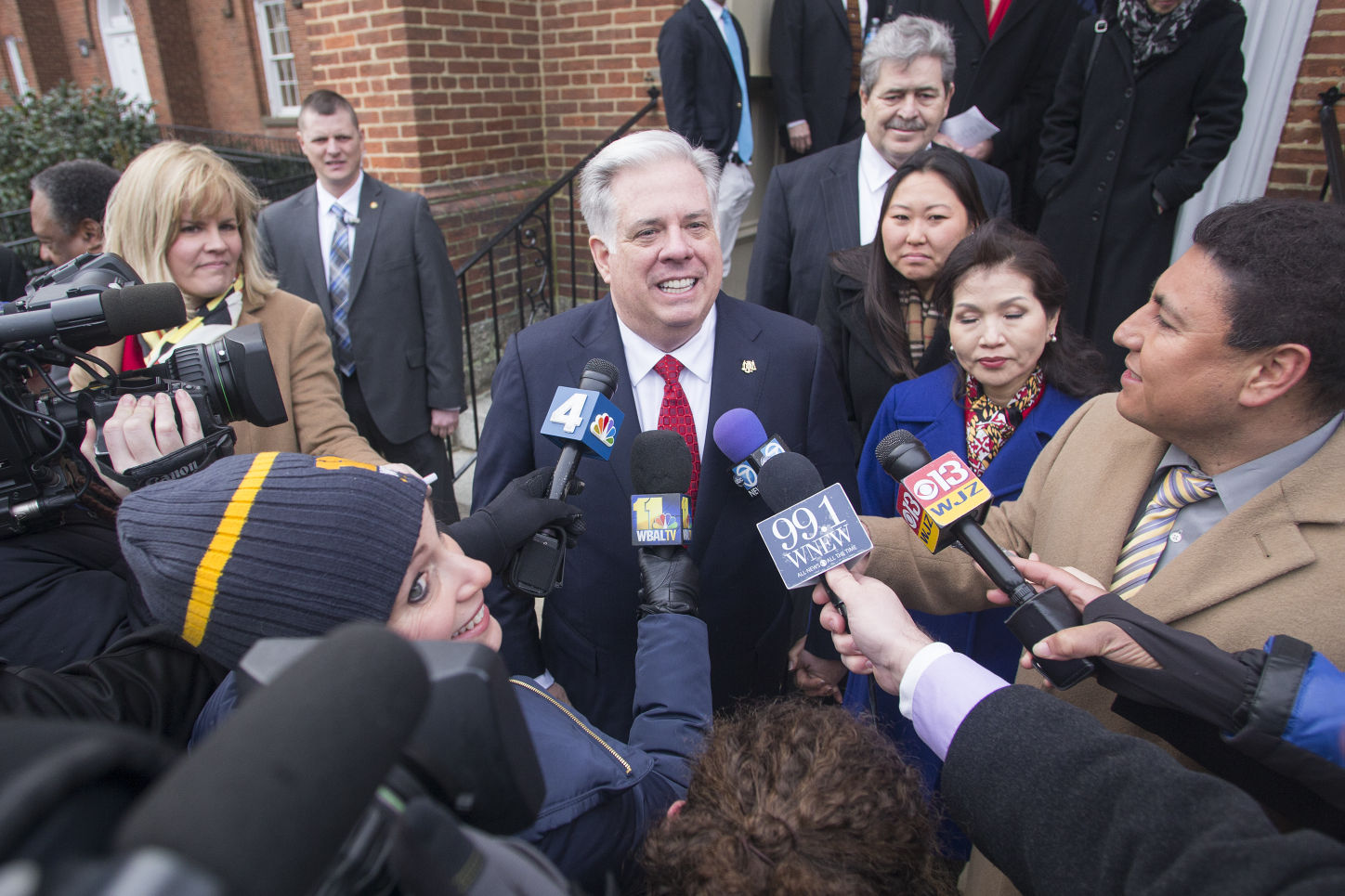
ANNAPOLIS — Recently elected Gov. Larry Hogan delivered his inaugural address Wednesday afternoon, promising to usher in an era of bipartisan cooperation and fiscal restraint.
“I am prepared to create an environment of trust and cooperation where the best ideas rise to the top based upon their merit, regardless of which side of the political debate they come from,” he said to thousands of onlookers in front of the State House in Annapolis.
Hogan then submitted his fiscal 2016 budget Friday, which included a projected 5 percent tuition increase at University System of Maryland institutions, despite overall system funding growing by 1.3 percent.
Tuition rates are set by the Board of Regents, which takes the governor’s budget projections into consideration. Hogan’s budget suggests the $15.4 million increase in system funding will not be enough to offset rising higher education costs, which would force students to pay a larger share of the cost.
“He is now faced with some huge budget cuts, and although we will advocate that we will be protected, I understand that there has to be shared pain among all state agencies,” university President Wallace Loh said.
Hogan, facing a $750 million revenue shortfall, cut state agency spending by 2 percent, which saved $118 million. He saved an additional $156 million by cutting state employees’ salaries. In a press conference Thursday, Hogan touted his “structurally balanced” budget and education funding.
“Maryland’s fiscal year 2016 budget establishes balance without slashing agencies, laying off workers and while fully funding education and all of our other essential priorities,” Hogan said to a governor’s reception room filled with members of the media on his first full day in office.
Fiscal 2016 begins July 1.
On Jan. 16, Loh announced a tuition increase of $152 for full-time resident undergraduates and $279 for full-time nonresident undergraduates for the spring semester in response to budget cuts former Democratic Gov. Martin O’Malley introduced for the latter half of fiscal 2015.
Following Loh’s increase, which includes a one-time fee of $76, in-state tuition for full-time undergraduate residents is $3,958 for the spring semester.
Tuition has increased 3 percent annually since 2011, following a four-year tuition freeze O’Malley instituted in 2007. From 2003 to 2006, tuition at this university rose 37 percent under Republican Gov. Robert Ehrlich.
Loh, who attended Wednesday’s inauguration, said Hogan’s message of economic development and job growth resonated with the university’s mission. Loh has met with Hogan and says he will continue to lobby in Annapolis for university funding throughout the spring legislative session.
Hogan is this state’s second Republican governor in 46 years, and his term will be the first time since 2007 that the Democratic party won’t dominate decision-making in Annapolis.
In his inauguration speech, Hogan stressed that government spending must be reduced to ease the burden on taxpayers.
“We must get the state government off our backs and out of our pockets so that we can grow the private sector, put people back to work and turn our economy around,” Hogan said to loud applause.
Hogan’s running mate, Boyd Rutherford, was sworn in as lieutenant governor after his son introduced him that day. Rutherford emphasized that he and Hogan have the same agenda and will work together.
“We will have a united executive branch, working together, serving all the people of Maryland,” Rutherford said. “One staff on the second floor [of the State House, in the governor’s office] working to carry out Governor Hogan’s vision.”
The proposed budget will now go through the state Senate and House of Delegates, which have the power to reduce funding but cannot increase spending or shift money among areas. The legislature must pass a budget by April 6, and Hogan’s signature is not required for final passage.
“The problem is, in Maryland, the governor has an extraordinary control over the budget,” said Sen. Paul Pinsky (D-Prince George’s), chairman of the Education Subcommittee. “What the governor introduces, we cannot really improve. … When it comes to policy, he’s got to pass it through a legislature that’s Democratically controlled. But when it comes to the budget, we have one hand, or maybe two, tied behind our back.”
Sen. Jim Rosapepe (D-Prince George’s), who represents College Park, said he was a strong proponent of O’Malley’s 3 percent tuition cap and will continue to press Hogan to add funding for this university.
“College affordability was one of the top priorities Governor O’Malley had, and this budget suggests that it is a lower priority for Governor Hogan,” Rosapepe said.
The Student Government Association will have a representative in Annapolis lobbying every day this semester, SGA President Patrick Ronk said, with the goal of ensuring tuition increases do not rise above 5 percent.
“A lot of people are feeling the pain, and higher ed isn’t feeling the pain as much as other people,” Ronk said. “I really think we should be grateful for that at this point. We knew there was going to be cuts, given the fiscal situation in the state. … A 5 percent tuition increase is not good, but it’s not as bad as it could be.”
Del. Adrienne Jones (D-Baltimore), chairwoman of the House Education and Economic Development Subcommittee, said the legislature has always been supportive of higher education, and she does not expect to have to reduce university funding, though she said the committee still needs to conduct a full review of the budget.
“My concern is, any time that you have a tuition increase, the impact on the students,” Jones said. “I really was concerned about that midterm increase that was just instituted last week because students didn’t really have a chance to plan.”
CORRECTION: In a previous version of this story, the headline incorrectly stated that Gov. Larry Hogan had proposed the 5 percent tuition hike for fiscal year 2016. The headline has been updated to reflect the change.



